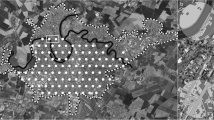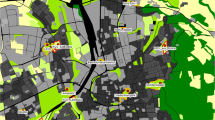Abstract
The spatial distribution of biodiversity has specific patterns in urban environments. The aim of this study was to compare the ecological profiles of plants in man-made traffic corridors and natural river corridors in the city of Vantaa. The number of corridor species represented 76.3 % of Vantaa’s total flora, even though corridors covered only 2.7 % of the city area. Corridor plants are mostly generalist species with wide ecological niches, and have ruderal and competitor life-strategies, while plants without occurrences in corridors are habitat specialists and species with narrow ecological niches. The conservation value of non-corridor habitats arises from the rarity of species, and the representation of the original boreal nature, while corridors contribute to the total diversity of species. The potential of corridors in urban conservation has not been fully appreciated.




Similar content being viewed by others
References
Angold PG (1997) The impacts of road upon adjacent heathland vegetation: Effects on plant species composition. J Appl Ecol 34:409–417
Angold PG, Sadler JP, Hill MO, Pullin A, Rushton S, Austin K, Small E, Wood B, Wadsworth R, Sanderson R, Thompson K (2005) Biodiversity in urban habitat patches. Sci Total Environ 360(1–3):196–204
Armitage D, de Loë R, Plummer R (2012) Environmental governance and its implications for conservation practice. Conserv Lett 5:245–255
Bundesamt für Naturschutz (2011) FloraWeb. <http://www.floraweb.de/>
Ernstson H, van der Leeuw S, Redman C, Meffert D, Davis G, Alfsen C, Elmqvist T (2010) Urban transitions: on urban resilience and human-dominated ecosystems. Ambio 39:531–545
Faeth S, Bang C, Saari S (2011) Urban biodiversity: patterns and mechanisms. Ann N Y Acad Sci 1223:69–81
Finnish Environment Institute (2012) Hydrological Yearbook 2006–2010. The Finnish Environment 8/2012. 234 pp
Forman RTT (1995) Land Mosaics. The Ecology of Landscapes and Regions. Cambridge University Press, Cambridge, 632 pp
Government decree 1.3 (2012) Valtioneuvoston päätös Euroopan unionin Natura 2000-verkoston Suomen ehdotuksen täydentämisestä
Grant EHC, Lowe WH, Fagan WF (2007) Living in the branches: population dynamics and ecological processes in dendritic networks. Ecol Lett 10(2):165–175
Gregory SV, Swanson FJ, McKee WA, Cummins KW (1991) An ecosystem perspective of riparian zones. Focus on links between land and water. BioSci 41(8):540–551
Grime JP (2002) Plant strategies, vegetation processes, and ecosystem properties. John Wiley & Sons Ltd., New York, 417 pp
Groffman P, Bain D, Band L, Gelt K, Brush G, Grove J, Poyat R, Yesilonis I, Zipperer W (2003) Down by the riverside: urban riparian ecology. Frontiers Ecol Environ 1(6):315–321
Hansen MJ, Clevenger AP (2005) The influence of disturbance and habitat on the presence of non-native plant species along transport corridors. Biol Conserv 125:249–259
Hunt R, Hodgson JG, Thompson P, Bungener P, Dunnett NP, Askew AP (2004) A new practical tool for deriving a functional signature for herbaceous vegetation. Appl Veg Sci 7(2):163–170
Hämet-Ahti L, Suominen J, Ulvinen T, Uotila P (eds) (1998) Retkeilykasvio (Field Flora of Finland), 4th edn. Finnish Museum of Natural History. Botanical Museum, Helsinki, 656 pp
Ives C, Taylor M, Nipperess D, Davies P (2010) New directions in urban biodiversity conservation: the role of science and its interaction with local environmental policy. Environ Plan Law J 27:249–271
Jodoin Y, Lavoie C, Villeneuve P, Theriault M, Bealieu J, Belzile F (2008) Highways as corridors and habitats for the invasive common reed Phragmites australis in Quebec, Canada. J Appl Ecol 45:459–466
Klotz S, Kühn I, Durka W (2002) BIOFLOR – Eine Datenbank mit biologisch-ökologischen Merkmalen zur Flora von Deutschland. Schriftenr Vegetationskunde 38:334
Kowarik I (2011) Novel urban ecosystems, biodiversity, and conservation. Environ Pollut 159:1974–1983
Körs A, Vilbaste S, Käiro K, Pall P, Piirsoo K, Truu J, Viik M (2012) Temporal changes in the composition of macrophyte communities and environmental factors governing the distribution of aquatic plants in an unregulated lowland river (Emajõgi, Estonia). Boreal Environ Res 17:460–472
Lahti T, Kurtto A, Väisänen R (1988) Floristic composition and regional species richness of vascular plants in Finland. Ann Bot Fenn 25:281–291
Massant W, Godefroid S, Koedam N (2009) Clustering of plant life strategies on meso-scale. Plant Ecol 205:47–56
Ministry of Agriculture and Forestry (Finland) (2012) Finland’s National Strategy on Invasive alien species. Ministry of Agriculture and Forestry. 126 pp
Müller N, Werner P (2010) Urban Biodiversity and the Case for Implementing the Convention on Biological Diversity in Towns and Cities. In: Werner P, Kelcey J (eds) Müller, N. Urban Biodiversity and Design, Wiley-Blackwell, pp 3–33
Nilsson C, Grelsson G, Johansson M, Sperens U (1989) Patterns of Plant Species Richness along Riverbanks. Ecology 70:77–84
Pierce J, Budd W, Lovrich N (2011) Resilience and sustainability in US urban areas. –. Environ Polit 20(4):566–584
Pincetl S (2012) Nature, urban development and sustainability – What new elements are needed for a more comprehensive understanding? Cities 29:532–537
Planty-Tabacchi A-M, Tabacchi E, Naiman R, DeFerrari C, Décamps H (1996) Invasibility of Species-Rich Communitites in Riparian Zones. Conserv Biol 10(2):598–607
Preston CD, Pearman DA, Dines TD (2002) New Atlas of the British and Irish Flora: an Atlas of the Vascular Plants of Britain, Ireland, the Isle of Man and the Channel Islands. Oxford University Press, Oxford, xi + 910 pp
Pyšek P, Prach K (1993) Plant invasions and the role of riparian habitats: a comparison of four species alien to central Europe. J Biogeogr 20:413–420
Ranta P (1990) Vantaanjoen vesistöalueen jokikäytäväkasveista Vantaalla ja Helsingissä. Lutukka 6:99–115 (In Finnish, with English summary)
Ranta P (2008) The importance of traffic corridors as urban habitats for plants in Finland. Urban Ecosyst 11:149–159
Ranta P, Siitonen M (1996) Vantaan luonto – Kasvit (Plant life in Vantaa). City of Vantaa. 442p
Ranta P, Tanskanen A, Siitonen M (1997) Vantaan kasvit: kaupunkiekologia, monimuotoisuus ja suojelu. Lutukka 3:67–87 (In Finnish, with English summary)
Reinikainen A, Mäkipää R, Vanha-Majamaa I, Hotanen J (eds.) (2000) Kasvit muuttuvassa metsäluonnossa. Tammi. 384p
Rosenberg DK, Noon BR, Meslow EC (1997) Biological corridors: form, function, and efficacy. Bioscience 47(10):677–687
Sandström U, Angelstam P, Khakee A (2006) Urban comprehensive planning – identifying barriers for the maintenance of functional habitat networks. Landsc Urban Plan 75:43–57
Sekercioglu CH (2009) Tropical ecology: riparian corridors connect fragmented forest bird populations. Curr Biol 19(5):210–213
Sokal RR, Rohlf FJ (1994) Biometry: the Principles and Practices of Statistics in Biological Research. W. H Freeman, Folkestone, 880 p
Säumel I, Kowarik I (2010) Urban rivers as dispersal corridors for primarily wind-dispersed invasive tree species. Landsc Urban Plan 94:244–249
Tikka PM, Koski PS, Kivelä R, Kuitunen MT (2000) Can grassland plant communities be preserved on road and railway verges? Appl Veg Sci 3:25–32
Tikka PM, Högmander H, Koski P (2001) Road and railway verges serve as dispersal corridors for grassland species. Landsc Ecol 16:659–666
Van Looy K, Meire P (2009) A conservation paradox for riparian habitats and river corridor species. J Nat Conserv 17(1):33–46
Vantaan kaupunki (2012) Vantaan kaupungin tilastollinen vuosikirja 2011 (Statistical yearbook of the city of Vantaa 2011). Vantaan kaupunki, Tietopalveluyksikkö. 130 pp
Way JM (1977) Roadside verges and conservation in Britain: a review. Biol Conserv 12:65–74
Werner P (1999) Why biotope mapping in populated areas? - In: Reumer JWF, Epe MJ (eds.) Biotope mapping in the urban environment. Deinsea 5: 9–26
Zerbe S, Maurer U, Peschel T, Schmitz S, Sukopp H (2004) Diversity of flora and vegetation in European cities as a potential for nature conservation in urban-industrial areas – with examples from Berlin and Potsdam (Germany). Proceedings 4th International Urban Wildlife Symposium. 35–49
Acknowledgments
The Finnish Biodiversity Programme (grant no. 39715) supported the fieldwork for this study. Thanks are due to Prof. Jari Niemelä for critical comments on the manuscript and the Water protection Association of the River Vantaa and Helsinki for statistical information. We are grateful to Mr. Pekka Rahkonen for help with the illustrations (Figs. 1 and 3) and Prof. Mary Cannon and Dr. Stephen Venn for improving the language.
Author information
Authors and Affiliations
Corresponding author
Appendix
Appendix
Rights and permissions
About this article
Cite this article
Ranta, P., Kesulahti, J., Tanskanen, A. et al. Roadside and riverside green – urban corridors in the city of Vantaa, Finland. Urban Ecosyst 18, 341–354 (2015). https://doi.org/10.1007/s11252-014-0402-z
Published:
Issue Date:
DOI: https://doi.org/10.1007/s11252-014-0402-z




